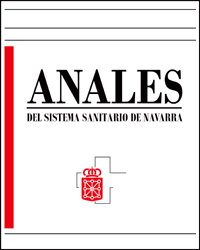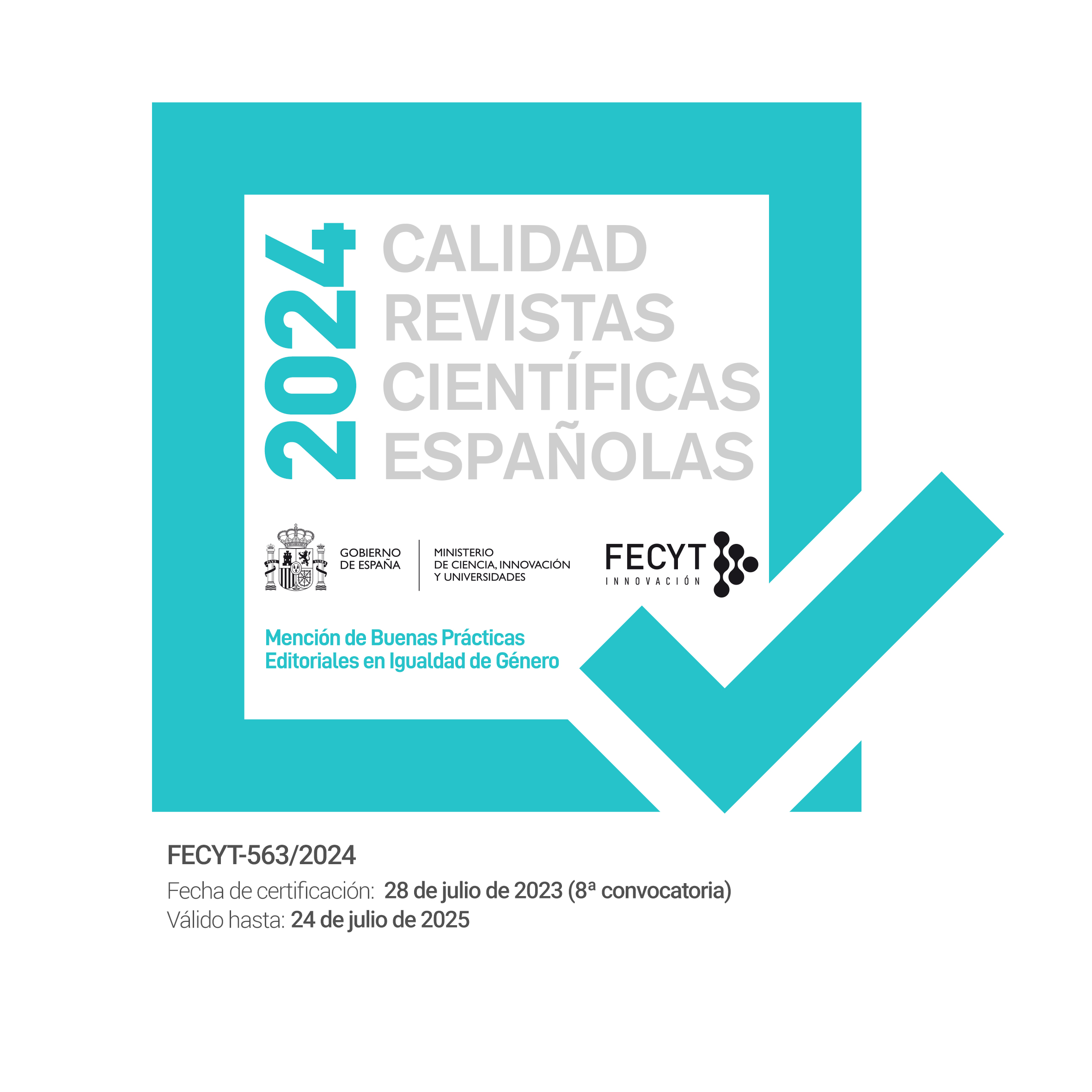Validación lingüística del Demand-Control-Support Questionnaire para profesionales de enfermería en España
DOI:
https://doi.org/10.23938/ASSN.0749Palabras clave:
Traducción. Adaptación transcultural. Cuestionarios. Estrés psicosocial. Enfermería.Resumen
Fundamento. Los profesionales de enfermería son uno de los grupos más afectados por el estrés laboral, lo que puede afectar la calidad de vida del profesional y comprometer la calidad de los cuidados de enfermería. A nivel internacional, el Demand-Control-Support Questionnaire (DCSQ) ha demostrado ser una herramienta breve, válida y fiable para evaluar el estrés laboral. El objetivo de este estudio fue obtener una versión adaptada al español del DCSQ para profesionales de enfermería.
Método. La validación lingüística se realizó en dos fases: 1) traducción-retrotraducción y adaptación lingüística del instrumento y 2) validación de contenido del instrumento mediante un panel de siete expertos y evaluación de la aplicabilidad y comprensión de la versión adaptada en una muestra de veintiún profesionales de enfermería.
Resultados. Fase 1) En el proceso de traducción, un ítem precisó cambios semánticos, mientras que cinco ítems precisaron cambios sintácticos. Las retrotraducciones fueron similares. Las dudas más relevantes se encontraron en el ítem 5, identificado como un ítem problemático a lo largo de todo el proceso. Fase 2) El análisis de la validez de contenido mostró excelentes resultados (índice de validez de contenido ≥ 0,90 y valores de kappa ≥ 0,65); además, el estudio piloto confirmó la adecuada comprensibilidad y aplicabilidad del cuestionario.
Conclusiones. El empleo de una metodología sistemática y rigurosa ha permitido obtener una versión adaptada al español del DCSQ, conceptual y lingüísticamente equivalente al instrumento original, y adecuada para valorar de manera multidimensional el estrés psicosocial de profesionales de enfermería en el ámbito laboral.
Descargas
Citas
SEWARD J, LARSEN R. Current occupational & environmental medicine. 5th ed. New York: McGraw-Hill, 2007.
MASE J, OTA A, INOUE K, IIDA T, TSUTSUMI A, YATSUYA H, ONO Y. Reliability and validity of the Japanese translated version of the Swedish Demand-Control-Support Questionnaire. Ind Health 2012; 50: 467-475. https://doi.org/10.2486/indhealth.ms1282
Instituto Nacional de Estadística. Estrés y satisfacción laboral 2018. https://www.ine.es/jaxi/Tabla.htm?path=/t15/p419/a2006/p02/&file=02018.px
Organización Mundial de la Salud. El efecto sobre la salud de los riesgos psicosociales en el trabajo: una visión general. Madrid: Instituto Nacional de Seguridad y Salud en el Trabajo (INSST) 2018. https://www.insst.es/documents/94886/538970/El+efecto+sobre+la+salud+de+los+riesgos+psicosociales+en+el+trabajo+una+visión+general.pdf/7b79def3-88be-4653-8b0e-7518ef66f518
STAVROULA L, GRIFFITHS A, COX T. La organización del trabajo y el estrés: estrategias sistemáticas de solución de problemas para empleadores, personal directivo y representantes sindicales. Ginebra: Organización Mundial de la Salud 2004. https://www.who.int/occupational_health/publications/stress/es/
Agencia Europea para la Seguridad y la Salud en el Trabajo. Cómo abordar los problemas psicosociales y reducir el estrés relacionado con el trabajo. Luxemburgo: Oficina de Publicaciones Oficiales de las Comunidades Europeas 2003. https://osha.europa.eu/es/publications/reports/309
SARAFIS P, ROUSAKI E, TSOUNIS A, MALLIAROU M, LAHANA L, BAMIDIS P et al. The impact of occupational stress on nurses’ caring behaviours and their health related quality of life. BMC Nurs 2016; 1: 56. https://doi.org/10.1186/s12912-016-0178-y
LEINEWEBER C, MARKLUND S, ARONSSON G, GUSTAFSSON K. Work-related psychosocial risk factors and risk of disability pension among employees in health and personal care: a prospective cohort study. Int J Nurs Stud 2019; 93: 12-20. https://doi.org/10.1016/j.ijnurstu.2018.10.009
MCGRATH A, REID N, BOORE J. Occupational stress in nursing. Int J Nurs Stud 2003; 40: 555-565.
CARRILLO-GARCÍA C, RÍOS-RÍSQUEZ MI, MARTÍNEZ-HURTADO R. Nivel de estrés del personal de enfermería de la Unidad de Cuidados Intensivos de un hospital clínico universitario. Enferm intensiva 2016; 27: 89-95. https://doi.org/10.1016/j.enfi.2016.03.001
LEAL-COSTA C, DÍAZ-AGEA JL, TIRADO-GONZÁLEZ S, RODRÍGUEZ-MARÍN J, VAN-DER HOFSTADT CJ. Las habilidades de comunicación como factor preventivo del síndrome de Burnout en los profesionales de la salud. An Sist Sanit Navar 2015; 38: 213-223. https://doi.org/10.4321/s1137-66272015000200005
TENG CI, HSIAO FJ, CHOU TA. Nurse-perceived time pressure and patient-perceived care quality. J Nurs Manag. 2010; 18: 275–284. https://doi.org/10.1111/j.1365-2834.2010.01073.x
KARASEK R. Job demands, job decision latitude, and mental strain: implications for job redesign. Adm Sci Q 1979; 24: 285-308. https://doi.org/10.1111/j.1365-2834.2010.01073.x
KARASEK RA, THEORELL T. Healthy work: stress, productivity, and the reconstruction of the working life. New York: Basic Books, 1990.
JOHNSON J V, HALL EM. Job strain, work place social support, and cardiovascular disease: a cross-sectional study of a random sample of the Swedish working population. Am J Public Health 1988; 78: 1336–1342. https://doi.org/10.2105/ajph.78.10.1336
ESCRIBÀ V, MÁS R, CARDENAS M, PÉREZ S. Validación de la escala de estresores laborales en personal de enfermería: the nursing stress scale. Gac Sanit 1999; 13: 191-200. https://doi.org/10.1016/s0213-9111(99)71350-6
FERNÁNDEZ SÁNCHEZ JC, PÉREZ-MÁRMOL JM, PERALTA RAMÍREZ MI. Influencia de factores sociodemográficos, laborales y de estilo de vida sobre los niveles de burnout en personal sanitario de cuidados paliativos. An Sist Sanit Navar 2017; 40: 421-431.
18.KARASEK RA, GRODON G, PIETROKOVSKY C, FRESE M, PIEPER C, SCHWARTZ J, FRY L, SCHIRER D. Job content questionnaire and user's guide. Lowell: University of Massachusetts Lowell, Department of Work Environment, 1985.
THEORELL T, PERSKI A, AKERSTEDT T, SIGALA F, AHLBERG-HULTEN G, SVENSSON J, et al. Changes in job strain in relation to changes in physiological state: a longitudinal study. Scand J Work Environ Heal 1988; 14: 189-196. https://doi.org/10.5271/sjweh.1932
GRIEP RH, ROTENBERG L, VASCONCELLOS AGG, LANDSBERGIS P, COMARU CM, ALVES MGM. The psychometric properties of demand-control and effort-reward imbalance scales among Brazilian nurses. Int Arch Occup Environ Health 2009; 82: 1163-1172. https://doi.org/10.1007/s00420-009-0460-3
HÖKERBERG YHM, REICHENHEIM ME, FAERSTEIN E, PASSOS SRL, FRITZELL J, TOIVANEN S, et al. Cross-cultural validity of the demand-control questionnaire: Swedish and Brazilian workers. Rev Saude Publica 2014; 48: 486-496. https://doi.org/10.1590/s0034-8910.2014048005126
SANNE B, TORP S, MYKLETUN A, DAHL AA. The Swedish Demand—Control—Support Questionnaire (DCSQ): Factor structure, item analyses, and internal consistency in a large population. Scand J Public Health 2005; 33: 166-174. https://doi.org/10.1080/14034940410019217
ALVES MGM, CHOR D, FAERSTEIN E, LOPES CS, WERNECK GL. [Short version of the "job stress scale" : a Portuguese-language adaptation]. Rev Saude Publica 2004; 38: 164-171. https://doi.org/10.1590/s0034-89102004000200003
HÖKERBERG YHM, AGUIAR OB, REICHENHEIM M, FAERSTEIN E, VALENTE JG, DE JESUS FONSECA M et al. Dimensional structure of the demand control support questionnaire: a Brazilian context. Int Arch Occup Environ Health 2010; 83: 407-416. https://doi.org/10.1007/s00420-009-0488-4
CHUNGKHAM HS, INGRE M, KARASEK R, WESTERLUND H, THEORELL T. Factor structure and longitudinal measurement invariance of the demand control support model: an evidence from the Swedish Longitudinal Occupational Survey of Health (SLOSH). PLoS One 2013; 8: e70541. https://doi.org/10.1371/journal.pone.0070541
MAUSS D, HERR RM, THEORELL T, ANGERER P, LI J. Validating the demand control support questionnaire among white-collar employees in Switzerland and the United States. J Occup Med Toxicol 2018; 13: 1-7. https://doi.org/10.1186/s12995-018-0188-7
SOUSA VD, ROJJANASRIRAT W. Translation, adaptation and validation of instruments or scales for use in cross-cultural health care research: a clear and user-friendly guideline. J Eval Clin Pract 2011; 17: 268-274. https://doi.org/10.1111/j.1365-2753.2010.01434.x
WHO. Process of translation and adaptation of instruments. https://www.who.int/substance_abuse/research_tools/translation/en/#
GRANT JS, DAVIS LL. Selection and use of content experts for instrument development. Res Nurs Health 1997; 20: 269-274. https://doi.org/10.1002/(sici)1098-240x(199706)20:3<269::aid-nur9>3.0.co;2-g
POLIT DF, BECK CT, OWEN SV. Is the CVI an acceptable indicator of content validity? Appraisal and recommendations. Res Nurs Health 2007; 30: 459-467. https://doi.org/10.1002/nur.20199
DRENNAN J. Cognitive interviewing : verbal data in the design and pretesting of questionnaires. J Adv Nurs 2003; 42: 57-63. https://doi.org/10.1046/j.1365-2648.2003.02579.x
CARVAJAL A, CENTENO C, WATSON R, MARTÍNEZ M, SANZ RUBIALES Á. ¿Cómo validar un instrumento de medida de la salud? An Sist Sanit Navar 2011; 34: 63-72. https://doi.org/10.4321/s1137-66272011000100007
HIDALGO OVEJERO AM, MENÉNDEZ GARCÍA M, BERMEJO FRAILE B, GARCÍA MATA S, FORCÉN ALONSO T, MATEO SEBASTIÁN P. Cross-cultural adaptation of the Zurich Claudication Questionnaire: validation study of the Spanish version. An Sist Sanit Navar 2015; 38: 41-52. https://doi.org/10.4321/s1137-66272015000100005
FARIÑA-LÓPEZ E, ESTÉVEZ-GUERRA GJ, NÚÑEZ GONZÁLEZ E, CALVO FRANCÉS F, PENELO E. Adaptación y validación española del Perception of Restraint Use Questionnaire (PRUQ) sobre el uso de restricciones físicas en personas mayores. An Sist Sanit Navar 2016; 39: 13-22. https://doi.org/10.1016/j.regg.2013.01.005
TERWEE CB, BOT SD, DE BOER MR, VAN DER WINDT DA, KNOL DL, DEKKER J et al. Quality criteria were proposed for measurement properties of health status questionnaires. J Clin Epidemiol 2007; 60: 34-42. https://doi.org/10.1016/j.jclinepi.2006.03.012
POLIT DF, BECK CT. The content validity index: are you sure you know what’s being reported? Critique and recommendations. Res Nurs Health 2006; 29: 489-497. https://doi.org/10.1002/nur.20147
LIMA-SERRANO M, VARGAS-MARTÍNEZ A M, GIL-GARCÍA E, MARTÍNEZ-MONTILLA JM, LIMA-RODRÍGUEZ JS, VRIES H.D. Adaptación y validación al español de cinco escalas para evaluar los determinantes del consumo de alcohol en adolescentes. An Sist Sanit Navar 2017; 40: 221-236. https://doi.org/10.23938/ASSN.0028
POLIT DF, YANG FM. Measurement and the measurement of change: a primer for the health professions. 1st ed. Philadelphia: Wolters Kluwer, 2014.
DOVAL E, VILADRICH C. Desarrollo y adaptación de cuestionarios en el ámbito de la Salud. 10ª ed. Bellaterra: Laboratori d’ Estadística Aplicada i de Modelització (UAB); 2017.
Publicado
Cómo citar
Número
Sección
Licencia
Derechos de autor 2020 Anales del Sistema Sanitario de Navarra

Esta obra está bajo una licencia internacional Creative Commons Atribución-CompartirIgual 4.0.
La revista Anales del Sistema Sanitario de Navarra es publicada por el Departamento de Salud del Gobierno de Navarra (España), quien conserva los derechos patrimoniales (copyright ) sobre el artículo publicado y favorece y permite la difusión del mismo bajo licencia Creative Commons Reconocimiento-CompartirIgual 4.0 Internacional (CC BY-SA 4.0). Esta licencia permite copiar, usar, difundir, transmitir y exponer públicamente el artículo, siempre que siempre que se cite la autoría y la publicación inicial en Anales del Sistema Sanitario de Navarra, y se distinga la existencia de esta licencia de uso.








